Table of Contents
Trough washers were among the earliest methods used for concentrating ores; they are referred to by Agricola about the middle of the sixteenth century as already being used while the hand-operated jigging sieve had only recently come into use. For cleaning coal the trough washer apparently was first used in France and Belgium about 1841. The early trough washers were intermittent and the refuse at least was shoveled out by hand. The invention of a continuous jig washer, by a Frenchman, Berard, in 1848, acted as a stimulus to coal washings in jigs and retarded progress in trough washing in the nineteenth century.
The Rheolaveur
A Belgian engineer, Antoine France, is responsible for the development of means to remove refuse materials continuously from a trough washer, while preserving stratification and preventing the loss of coal with the refuse. The methods and equipment devised, which have become known throughout the world as rheolaveur, were initiated at the St. Nicholas mine near Liege, Belgium, about 1912.
This installation consisted of two units to wash 20 to 8-min. (3/16 to 5/16-in.) and 8-mm. to 0 (5/16-in. to 0), each having only two superimposed inclined troughs. The first few “Rheo” boxes on the top trough removed refuse directly and the remaining Rheo boxes discharged impure refuse to the lower trough for rewashing. On the lower trough the first few boxes removed refuse and the following boxes removed a middling product used for boiler fuel or other purposes. The overflow of both troughs was joined to form the washed coal product.
The unit cleaning the 13/16 to 5/16 in. size coal had only four rheo boxes, two being attached to each of the two troughs, which were 10 in. wide and 14 in. deep. This size of raw coal carried 26.9 per cent ash and was separated into clean coal at about 8 per cent ash, middlings at 31 to 32 per cent ash and refuse analyzing 69 to 72 per cent ash.
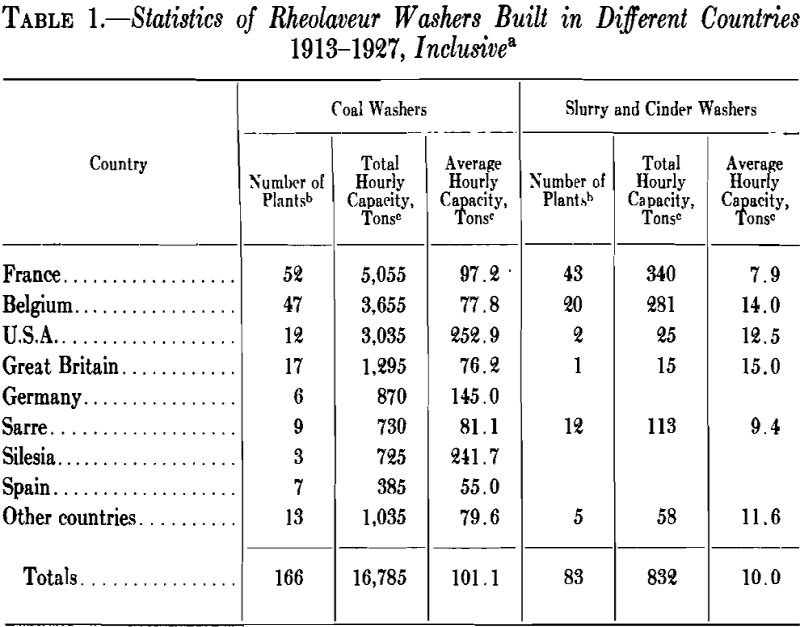
The first installation of the rheolaveur in the United States was made in 1923-1924 by the Hudson Coal Co., Scranton, Pa., at its Baltimore breaker, in the Wyoming anthracite district near Wilkes-Barre, Pa. This installation consisted of both coarse-coal and fine-coal units with a combined capacity of 200 tons per hour.
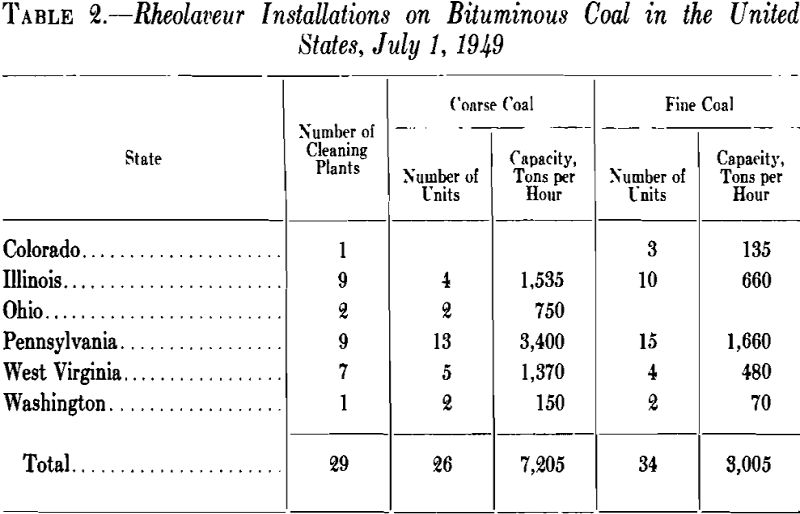
The first rheolaveur installed in the United States to clean bituminous coal was made in the Cokedale washery of the American Smelting and Refining Co. near Trinidad, Colorado, in 1926. Table 2 lists the rheolaveur plants in operation in the United States up to July 1, 1949.
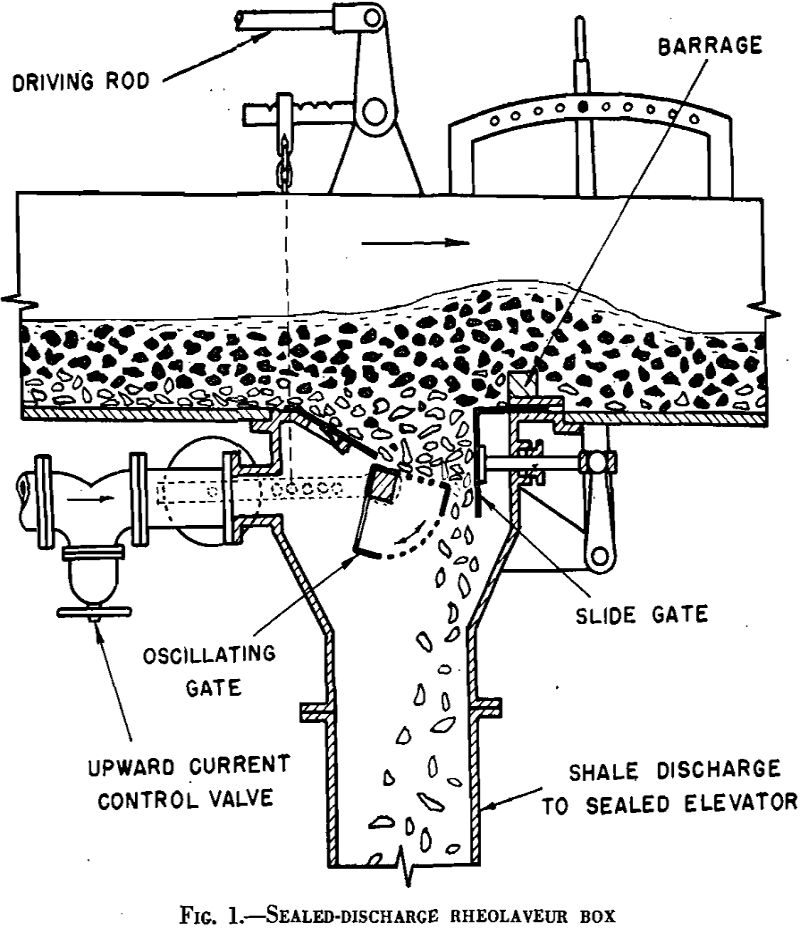
Free-discharge Rheolaveur for Fine Coal
The fine coal rheolaveur differs from the coarse coal rheolaveur by the type and number of boxes used. The rate of discharge is not controlled by gates, but the size of the orifice at the bottom of the box.
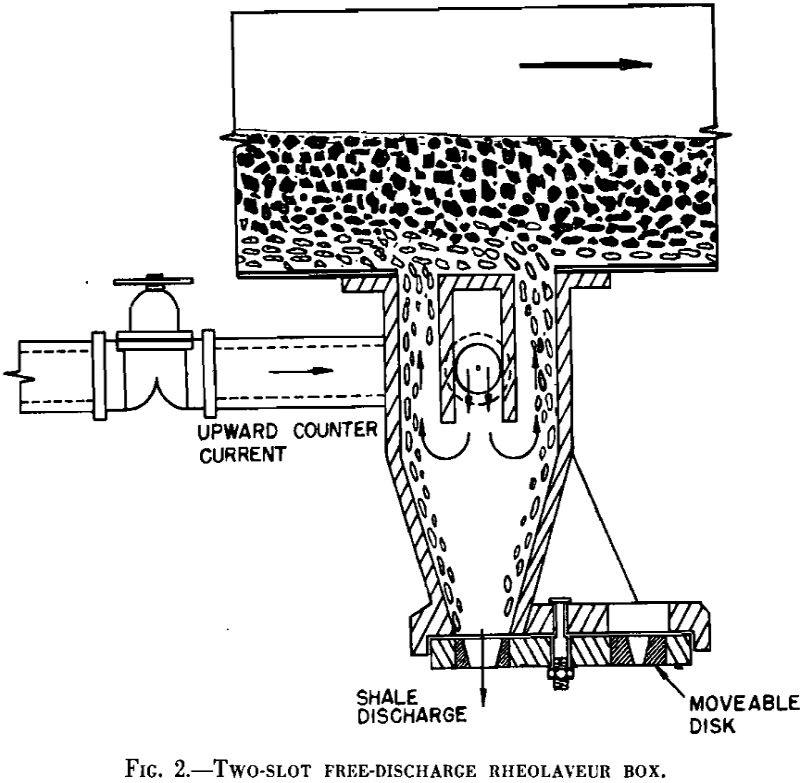
A revolving disk provides five different holes, and disks of four different sizes are available, giving a total size range of from 5/16- to 2¾-in. diameter. A more flexible control is obtained with another type of box, which has an easily replaceable bushing instead of a disk. Some boxes may be equipped with a vertical countercurrent. Where the launder width exceeds 14 in., it is split by a partition and double boxes are used.
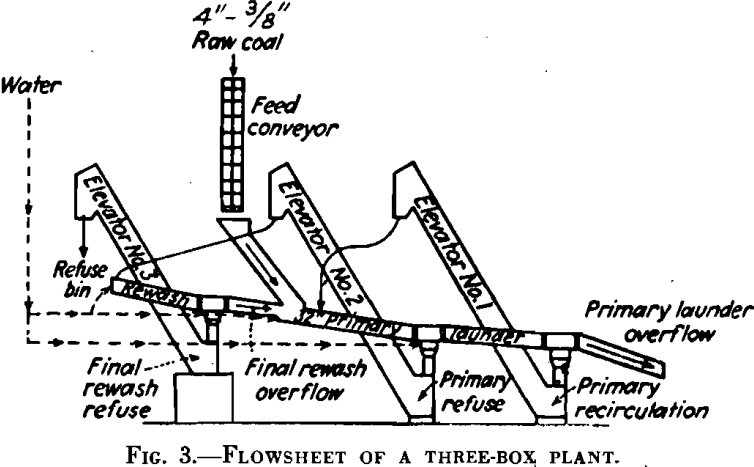
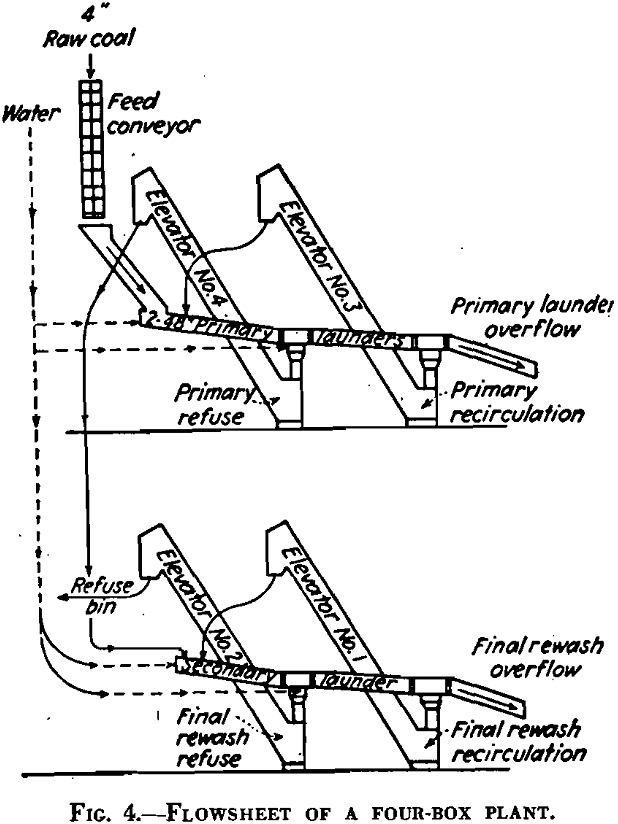
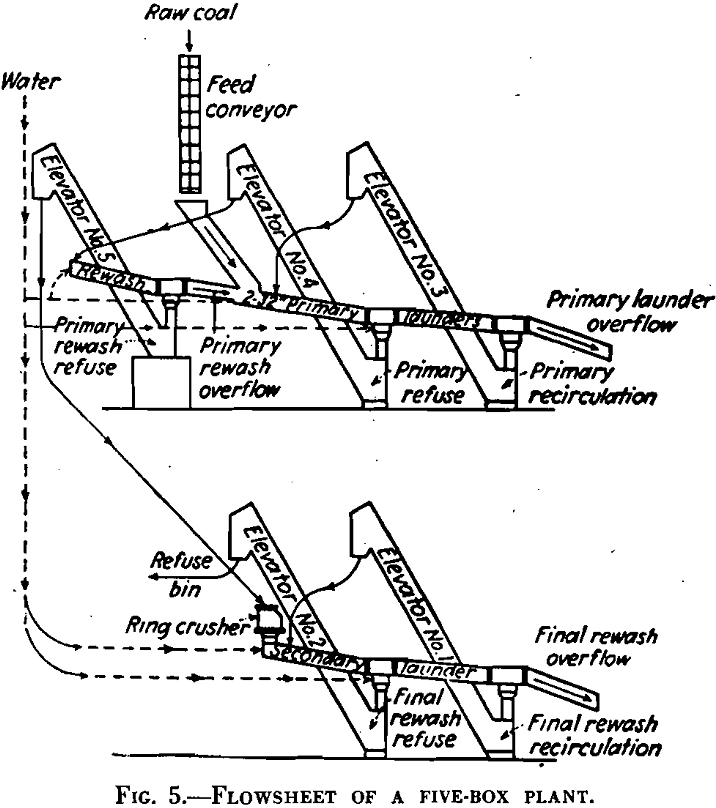
Several attempts were made to improve the washing in the final rewash launder by returning the recirculation material from this launder to the head of the primary launders. While this considerably reduced the amount of stoker coal produced and bettered the separation in the rewash launder, the effect on the primary launders was bad because it increased the amount of 1.40-sink material in the overflow. It is believed that the rewash launder gained more by the removal of the recirculating load of minus 3/8-in. material than from the removal of the plus 3/8-in. size; and, although the plant layout at present does not permit it, it is believed that the return of the rewash recirculating material to the head of the primary rewash launder would reduce the amount of stoker coal made, without detrimental effect on the primary launders if the minus §-in. size was first removed from the rewash recirculating material.
The moving mass between two boxes in a launder usually classifies somewhat better than the mass ahead of the first box. Some material, but very little water, has been taken out through the first box and the fluidity in the washing section ahead of the second box is thereby increased and classification improved. This may mean that nearly all of the remaining fine refuse will be removed in the second box because a better separation of slate, and especially of intermediate-gravity (1.40 to 1.60) material, is possible than with the first box.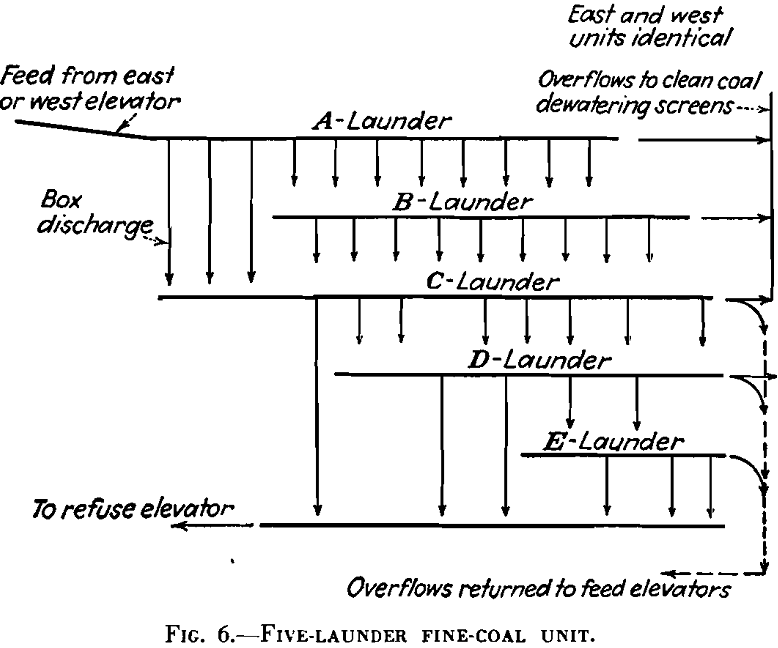
Plant Circuits and Operating Results
The plant is so designed that different circuits can be used to conform with varying technical or economical conditions.
When the circuit shown in Fig. 7 is used, all minus 3/8-in. coal is treated in the fine-coal plant with both units running in parallel, each taking half of the feed and making a four-product separation of metallurgical coal, steam coal, middlings and refuse, middlings being returned to the feed. The overflows of launders A and B are metallurgical coal, that of C, and occasionally of D, is steam coal, and E is recirculated. When the product of launder D is not put out as steam coal, it likewise is recirculated. Table 8 shows results of tests run with this circuit at the time about 50 tons per hour, exclusive of recirculating material, was being fed to each unit.
It must be understood that where the analyses of an item in one table do not agree with the analyses of the same item in another table, changes in the circuit, or coal fed to the plant, or grade of coal desired from the plant,
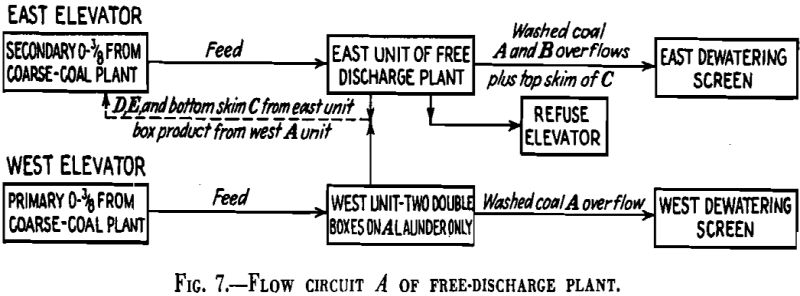
Continued increase in the amount of minus 3/8-in. coal to be cleaned finally made it necessary to increase the capacity of the fine-coal plant. This was done by using concentrating tables to treat the finer sizes of the recirculation material, the build-up of which in the circuit was detrimental to the removal of the large particles of high-gravity material. For this table circuit the overflows of launders D and E are combined and screened at 6-mesh. The oversize is recirculated to the head end of launder A, and the undersize is separated by the tables in three products: concentrates joining the overflows of launders A, B, and C; middlings returning with the feed to the tables; and refuse.
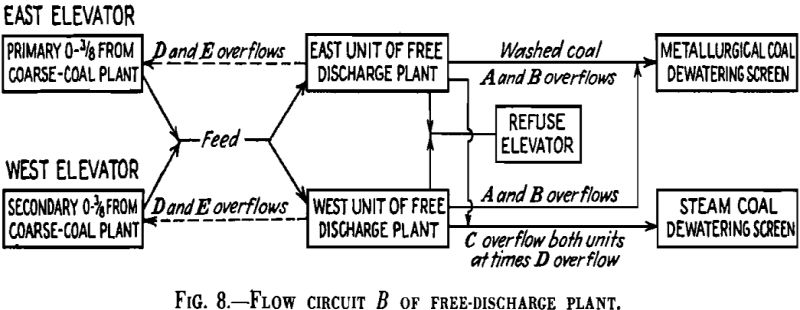
Koppers-Battelle Launder
The Koppers-Battelle launder is a compact unit developed at the Battelle Memorial Institute, Columbus, Ohio, for the washing of fine coal. The unit requires a small amount of floor space and little. head-room, and therefore a minimum cost for housing installation.
The feed enters the unit with a small amount of water. Additional water is introduced through the bottom of the first section of the launder by means of compartmented boxes covered by finely perforated plate. This water starts the material flowing down the launder and also acts to classify the material by keeping the bed in a fluid condition in this section of the launder.
The washing section of the launder consists of closely spaced drawoff boxes, which means an almost continuous draw of refuse or middlings as the material flows down the launder, the space between the pockets being only that required to house the mechanism for withdrawing the refuse or middlings. The first boxes produce a final refuse and last boxes produce a middlings product that is returned to the feed to be re-treated.
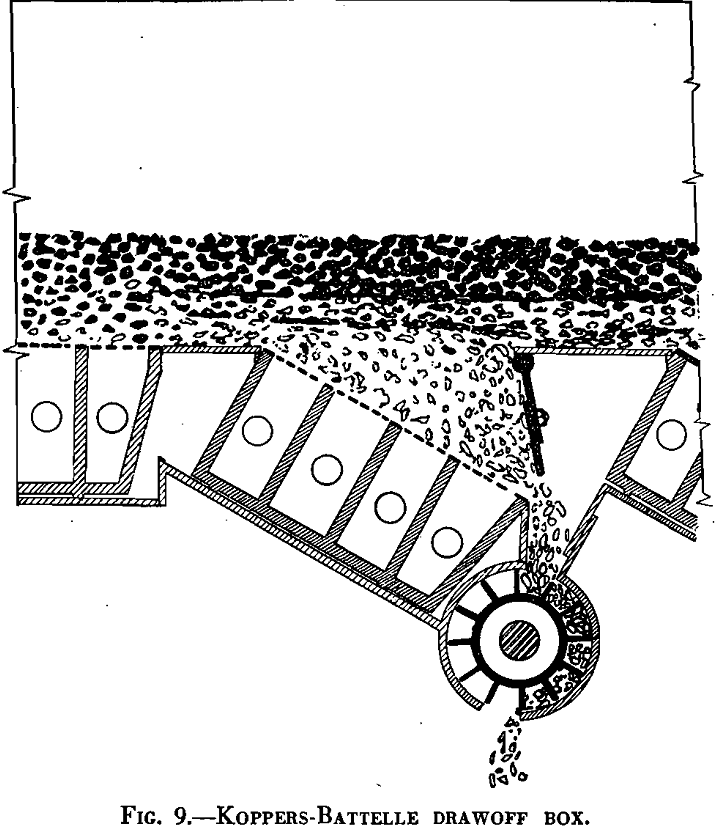
The rotary motion actuating the refuse draws is imparted by a wheel and pawl arrangement, with the pawl adjustable to engage any number of teeth from one to eight. All 14 draws are given by a common connecting rod running the length of the washing section. To accommodate unusual surges of refuse in the feed, the driving mechanism of the connecting rod is equipped with a variable-speed drive unit.

